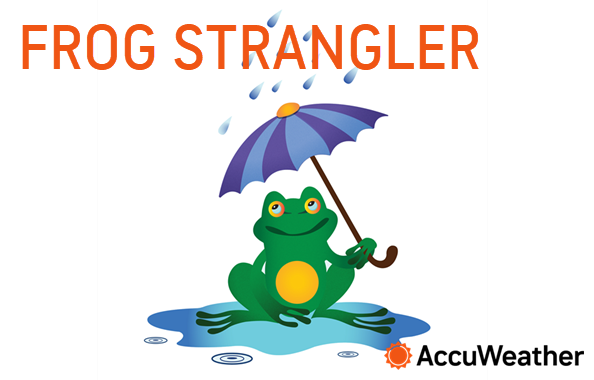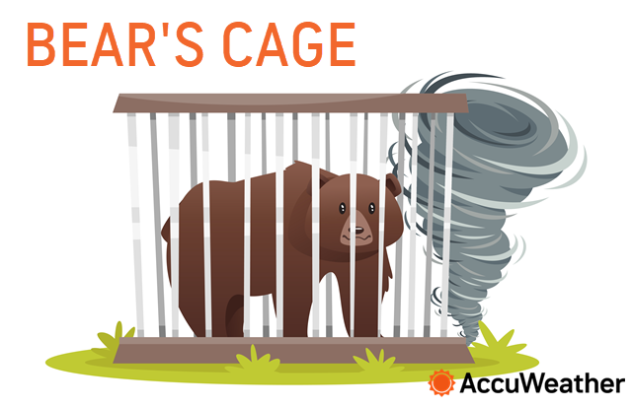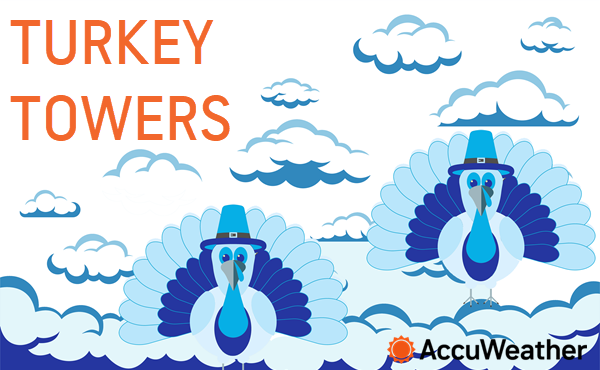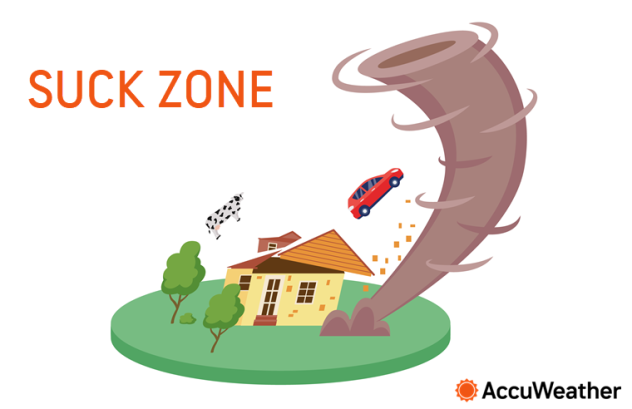10 wacky weather words to add to your vocab
- Oops!Something went wrong.Please try again later.
Beyond more common weather terms lies a field of rarely used but humorous monikers to describe the weather around us. Some were just invented, some have been around for hundreds of years. Here are a few of our favorites:
 |
The term "Frog Strangler" dates back to 1870, according to a post on StackExchange. Almost all the variants of the colloquialism, which begin with "frog" or "toad," followed by "strangler," "choker," or "drowner," have emerged from the southern United States. The term refers to a heavy downpour of rain - apparently capable of strangling frogs.
Although they can breathe underwater, frogs can, in fact, drown, WritingExplained.com says. Here's the interesting scientific sidebar: rainwater contains less oxygen than fresh water that falls to earth. This could make frogs drown faster than the heavy rain might typically cause, the StackExchange post surmises.
 |
One of the most recent additions to our list of wacky weather terms is "Gorilla Hail," a term coined on Twitter by Extreme Meteorologist Reed Timmer during a Texas storm in April 2020. The term means what you'd think it means - huge hail. (Other Reed-isms that didn't make this list include "Hog Leg" and "Bird Fart").
During that hail barrage, hailstones over 3 inches in diameter completely smashed the windshield and windows of Timmer's vehicle, leaving pock marks on the rest of it. Another famous Gorilla Hail event occurred during Timmer's live-streaming storm chase (again, in Texas) on April 13, 2021, which resulted in a viral video -- and the term's use became widespread in the storm chaser community.
 |
This odd phrase has a surprisingly robust worldwide etymology, with the type of animal varying in each culture. It's not just monkeys getting married, but rats in Arabic countries, bears in Bulgaria, foxes in Italy and parts of the southwest U.S., jackals in India, and tigers in Japan.
What it refers to is also known more simply as a "sunshower" -- a rain shower while the sun is out. Why all the animals, and why getting married? World Wide Words admits it's "baffling" but offers up the list above, which it notes is not comprehensive. By the way, Hindu mythology dictates that monkeys are idols, and in fact, two monkeys did get married in India in 2014 - though not of their own accord, and, as far as we know, not during a sunshower.
 |
The "sting jet" involves neither bees nor airplanes, but it can be an important severe weather ingredient that leads to damaging winds.
A meteorological term popular in the United Kingdom since 2004, a "sting jet" is a small area of intense winds that can develop underneath low-pressure systems, causing extensive wind damage.
The formation looks like a bee's stinger or scorpion's tail on weather satellites and 3D atmospheric maps. "Jet" is short for jet stream, a corridor of high winds high in the atmosphere.
 |
You may recall the character Dusty the storm chaser (played by the late Philip Seymour Hoffman) in the movie Twister exclaiming, "They're in the bear cage!" when Jo and Bill neared a tornado. This term, more commonly "Bear's Cage," has been part of storm chaser vernacular since at least 1996, when it was uttered in StormTrack magazine, a storm chaser publication.
On the pages of that classic black-and-white magazine, according to a 2014 tribute paper written by fellow chaser Tim Marshall, the late Al Moller, a veteran storm chaser, described the Dougherty, Texas, tornado of June 1995 as becoming "a rain-wrapped bear's cage" before the storm chaser repositioned.
According to the official Storm Chaser FAQ, the bear's cage is not just the location where the tornado will, or has, dropped down, but is also where the view is literally blocked from view by rotating walls of rain or hail and, although not true in the Twister scene, this area is particularly dangerous for a storm chaser to enter.
 |
Have you ever heard of a storm with feet? Not feet of snow, but rain. When a surge of rain falls out of a thunderstorm and hits the ground, pushes outward into a foot shape. This can indicate a "microburst" that can cause high winds and even crash planes.
Although the term "rain foot" is not included in the 1989 storm spotter publication "Microbursts: A Handbook for Visual Identification," that paper does have several examples of the phenomenon, calling it a "footlike bulge" and "foot-shaped prominence." The update to the online manual published in 1997 includes the term and several new illustrations, as does the most updated version "A Guide to Being a SKYWARN Spotter" from 2011.
 |
"Turkey Towers" is storm chaser slang for clouds that rapidly build upwards, exhibiting a turkeylike "neck." The term was likely invented by storm chasers in the 1980s, or earlier. It can be a sign that the atmosphere's "cap" has broken, meaning that strong thunderstorms could quickly develop.
The term first appeared in the initial publication of the "Weather Glossary for Storm Spotters" published by the National Weather Service in Norman, Oklahoma in 1992. One of the earliest videos describing the cloud formation appears in a 1994 storm chaser training film.
 |
That phrase is famous enough to have its own entry in The Urban Dictionary, and no, it's not dirty; it's, in fact, Dusty.
We may not be able to credit Dusty the storm chaser with "Bear's Cage" but we can certainly point to him in this famous scene in Twister, where he says, "'The Suck Zone.' It's the point basically when the twister ... sucks you up. That's not the technical term for it, obviously."
Prior to Twister, this term did not exist. Plus, as a storm chasing tour company points out, scientifically speaking, tornadoes don't suck, they blow.
 |
A "sling psychrometer" is a weather instrument that isn't used much anymore these days. It has two thermometers, one with a wet cotton wick around the thermometer's bulb. After literally slinging them around in a circle for 60 seconds, you'll know your "wet bulb" and "dry bulb" temperature, which is the actual temperature. Using a Psychometric Chart, you can calculate the dew point and relative humidity.
Another way to measure humidity is using human hair. The "hair hygrometer" was invented in the late 1700s, around the time the sling psychrometer came into use.
At the end of the 19th century, an alternate version of the sling psychrometer came out with a name almost good enough for this list: The Assman Psychrometer. Invented by German meteorologist Adolph Assman (we're not making this up), this instrument was a version in which the slinging was automated by a fan. In modern times, more complicated electronic moisture sensors have replaced both types of instruments.
 |
Another hit from the 1992 "Weather Glossary for Storm Spotters," this weather term sounds like a disappointing drink at prom, but this one refers to a surge of dry air rushing ahead of the dry line.
The "dry line" is a wall of dry air that typically moves eastward during the day in the southern Plains. The dry punch (stay with us here) can create a dry bulge in the dry line, which can create a focal point for severe thunderstorms.
Illustrations provided by Getty
Want next-level safety, ad-free? Unlock advanced, hyperlocal severe weather alerts when you subscribe to Premium+ on the AccuWeather app. AccuWeather Alerts™ are prompted by our expert meteorologists who monitor and analyze dangerous weather risks 24/7 to keep you and your family safer.












